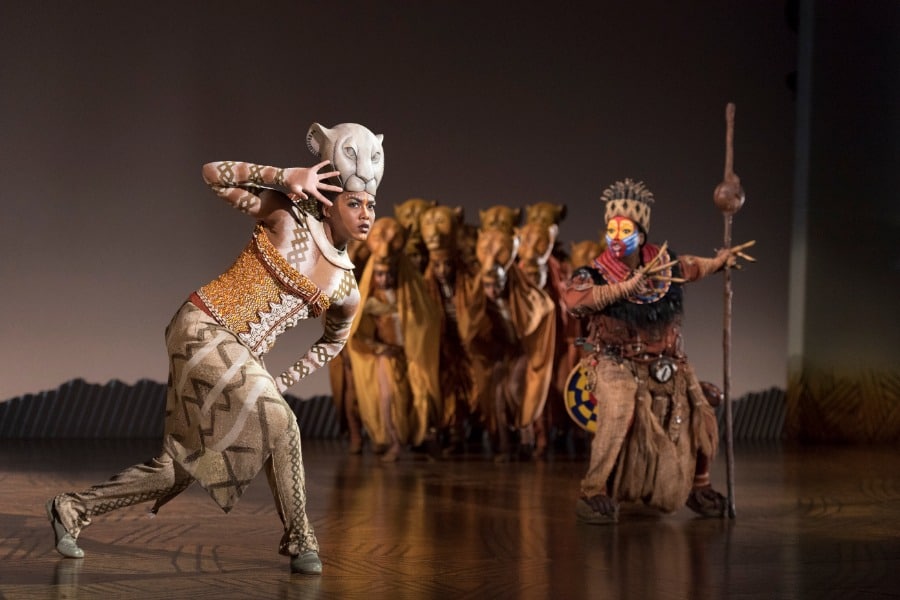DCPA NEWS CENTER
Enjoy the best stories and perspectives from the theatre world today.
Enjoy the best stories and perspectives from the theatre world today.

Nia Holloway as Nala, Buyi Zama as Rafiki and The Lionesses in THE LION KING North American Tour © Disney. Photo by Deen van Meer.
Long before masks were ever considered “personal protective equipment,” they were functional works of art. In Africa, for instance, they are meant to be used and serve ceremonial purposes: Accepting a boy into manhood, exorcising evil spirits, capturing invisible supernatural forces and…to tell stories.
Seen on a wall or a table, a mask may seem static, but when used in storytelling or a ceremony, the mask comes alive.
So was the goal when Tony Award-winning Director Julie Taymor brought Disney’s The Lion King to theatrical life.
Thomas Schumacher, president of Disney Theatrical Productions, knew that the only way to make The Lion King work on stage was to re-imagine the story in a completely theatrical way. So he tapped Taymor, an avant-garde director whose use of innovative, sometimes larger-than-life puppetry and breathtaking staging had taken the theatrical world by storm.
Once Taymor agreed to direct the project, the artistic vision fell into place.
She was very inspired by African masks, which are, “more abstract, much more stylized, much more essential than the characters’ faces from the animated film,” Taymor explained.
Working with renowned mask and puppet designer Michael Curry, Taymor and a team of skilled masks makers, sculptors, puppeteers and artisans spent 17,000 hours creating hundreds of masks for the original production.
As the show opens, the audience sees lions, baboons, elephants, rhinos, zebras, giraffes, cheetahs, birds, all coming to honor the new prince. But upon closer look, the human performer is also exposed under every animal costume and mask.
“Julie’s idea was very different,” said Schumacher, “because she said that although this is a story told with animals, it’s a human tale. And so to do that she wanted humans revealed at all times. Whether you play a principal character, whether you play an ensemble person who is an animal or a plant, you always see the person [actor].”
Taymor worked with the film’s co-director Roger Allers and screenwriter Irene Mecchi, who co-wrote the book for The Lion King stage adaptation, to tackle the challenge of creating animal characters from human performers. “Masks are actually very liberating for people because when you put on these things, you are released from yourself,” Taymor explained. “And so the operation of the puppetry and the movement of the actors with the masks is as important in storytelling as the story itself.”
Instead of having an audience gasp and wonder, “How did they DO that?”, Taymor wanted to reveal the HOW— the ropes, pulleys and wires that create the magic as well as the human beings that bring the characters to life. When special effects are hidden, the audience is passive, but by revealing the inner workings of its magic, The Lion King asks audience members to actively use their imaginations to “fill in the blanks.”
“The poetry in theatre is its transparency,” Taymor said. “We’re not fooling you to have you really think that you’re in the jungle, that you really think it’s a giraffe. We don’t need to do that in the theatre. We have an audience that’s dying to suspend their disbelief. Not willing…hungry. They’re there to be taken for a ride.”
Explore the masks of each animal character:
11 oz.
Mane is peacock feathers, mahogany & balsa wood
20 oz.
Hair is turkey feathers covered with cheese cloth & painted
16 oz. • 34 hours to make
Face is hand painted to look like wood
12 in the show
Each mask is hand painted with different tribal markings
The Lion King
Oct 23-Nov 16, 2025 • Buell Theatre
Tickets: denvercenter.org OR 303.893.4100
This article was compiled by material provided by Disney’s The Lion King including The Lion King DVD and The Lion King education video series.
